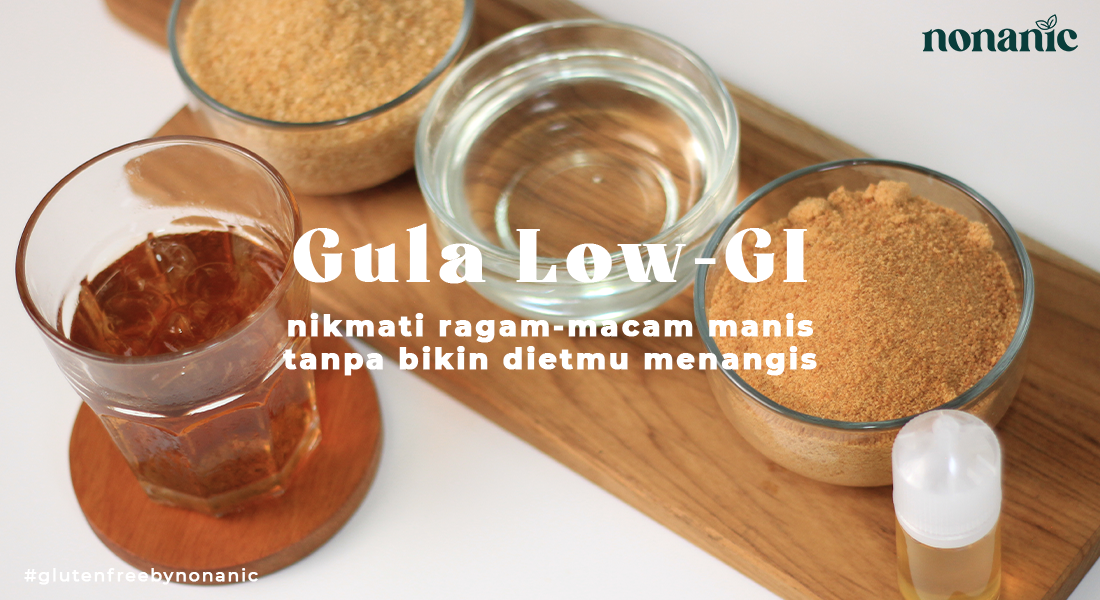Iced tea just leveled up! Low in calories like unsweetened tea and no drastic blood sugar spikes, so you can sip away in peace, Sweety! 😍

Did you know there are types of sugar you can consume without causing your blood sugar to skyrocket? Yup, these sugars make life a bit more chill and calm when enjoying sweet treats. No more panic after having something sugary because these sugars don't spike your blood sugar levels quickly!
These days, with added sugar everywhere, it feels almost impossible to cut back, right? But trust me, once you know the right types of sugar, you can still enjoy sweetness without worry. I'm about to spill the tea on sweeteners that digest more slowly, so the energy they provide lasts longer without causing a blood sugar spike. Safe, right?
Have you ever heard of the Glycemic Index (GI), or in Indonesian, Indeks Glikemik (IG)? For those unfamiliar, GI measures how quickly the food or drinks you consume raise your blood sugar. The lower the GI, the slower the rise. Foods with a low GI have values below 55. As a comparison, regular cane sugar has a GI of around 65, so it's classified as a medium GI sweetener (56-69).
Now, you're probably curious about which low-GI sugars can level up your iced tea, right? Let me spill the options you can try to keep life sweet without worrying about your blood sugar!

1. Use Sorghum Sugar
Per 10g: 33 kcal
GI: 50
This is one of the more popular low-GI sugar options. Sorghum sugar is made from 100% sorghum sap, which is gluten-free and non-GMO. The sap is crystallized into sorghum sugar crystals that you can use for food and drinks. Sorghum can be substituted 1:1 with regular cane sugar, making it easy to remember, right? With a GI of 50, sorghum sugar is perfect for those who want to consume sugar while still managing blood sugar levels.
Sorghum sugar has a gentle, natural sweetness, making it great for experimenting with healthy yet sweet recipes. And if you're on a gluten-free diet like me, this sugar is safe to use. No need to hesitate—just give it a try!
2. Use Cassava Sugar
Per 10g: 10 kcal
GI: 46
Next up is cassava sugar with a GI of 46. This sugar is made from cassava and is easier for the body to digest because it's fructose, or fruit sugar. It's liquid and 1.7 times sweeter than cane sugar. If you usually use 1 spoon of cane sugar, just half of that will give you the same sweetness with cassava sugar.
Cassava sugar has a mild and pleasant taste and, of course, doesn't cause blood sugar spikes. For those who haven't tried it yet, this could be a safe sweet choice for daily use.
Cassava sugar is also great for making gluten-free desserts. If you love baking, this sugar could be a healthier substitute for regular sugar.
3. Use Coconut Sugar
Per 10g: 38 kcal
GI: 35
This one is a fan favorite among people on a diet or those aiming for a healthier lifestyle. Coconut sugar, also known as palm sugar, has a relatively low GI of 35. It's made from coconut sap and usually comes in fine granules that look a bit like an anthill—hence the name "ant sugar" in Indonesian!
Besides being low-GI, coconut sugar has a unique, slightly caramel-like aroma. It's perfect for adding to coffee, tea, or even for making gluten-free cookies and cakes. Just like sorghum, coconut sugar can be used 1:1 as a substitute for cane sugar. Plus, it contains nutrients like iron, calcium, and potassium, so you're getting more than just sweetness!
4. Stevia
Per 1 drop: 0 kcal
GI: 0
Yes, I know this one is going to blow your mind! Stevia has a GI of 0! You read that right. Stevia is made from the Stevia rebaudiana plant, which contains steviol glycosides that are 100–400 times sweeter than regular sugar. So, you only need a tiny bit to get the right amount of sweetness.
Stevia could be the solution if you're trying to cut out sugar completely but still want to enjoy sweet things. Since its GI is zero, stevia doesn't affect your blood sugar at all, making it perfect for diabetics or those trying to lose weight. Stevia is great for sweetening drinks and cooking. For baking, it's ideal for brownies, cookies, or baked goods that don't rely on sugar for dough rising. Just one drop can replace two teaspoons of sugar.
Stevia is now widely available in the market in various forms—liquid, powder, even tablets. So, it's easy to use daily, just pick the form you like.


So, those are some low-GI sugar options that can replace regular cane sugar. No more worrying about blood sugar spikes after enjoying something sweet because now you have healthier options. Especially for those with blood sugar issues or on a gluten-free diet like me, these sugar options can be your go-to.
Don't be afraid to try and start replacing your cane sugar with one of the options above. Living healthy doesn't have to be bland—you can still indulge in sweetness with low-GI sugar!









